The Air Necessities
Often overlooked in the transition to a natural gas collection fleet is the cost of upgrading maintenance shops and providing training for maintenance personnel.
There are many costs involved when any fleet operation – much less one devoted to waste services – contemplates using natural gas to fuel its trucks.
First, there’s the hefty investment in trucks designed to operate on either compressed natural gas (CNG) or liquefied natural gas (LNG). According to Toronto-based global transportation consulting firm Frost & Sullivan, medium-duty spark-ignited CNG and LNG trucks can cost an additional $29,750 and $27,750, respectively, while the pricier “compression ignition” system used for LNG-powered heavy-duty Class 8 models can cost $72,450 or more on average than a comparable diesel-powered unit.
Natural gas itself currently costs $1 to $1.50 per diesel gallon equivalent (DGE), which has surpassed an average of $4 per gallon in the United States. Nevertheless, the U.S. Department of Energy notes that the cost to build a refueling station capable of dispensing CNG, LNG or both can range between $250,000 to over $1.5 million, depending on its size and scope.
Yet none of these figures touch on two more subtle costs fleets must account for when mulling a changeover to natural gas: first, training expenses to teach maintenance technicians how to take care of natural gas-driven technology, and second, the investments necessary to make their shops safe to service natural gas vehicles.
In the Shop
Republic Services, headquartered in Phoenix, currently operates more than 800 CNG- and LNG-powered refuse trucks, representing 6 percent of its total fleet of 15,000 vehicles. The firm plans to purchase another 550 natural gas vehicles in 2012, meaning 65 percent of all the new trucks Republic expects to buy this year will operate on natural gas.
Yet upgrading the shops earmarked to take care of all these natural gas-fired trucks – operating across the country from California to Indiana – required a significant amount of investment as well, notes Roy Svehla, Republic’s senior manager of fleet maintenance.
 “All shops require methane detection and adequate air flow to comply with code, primarily NFPA [National Fire Protection Association] code 52,” he explains. “Thus all of our shops [handling natural gas-powered trucks] are equipped with methane detection systems and improved exhaust fans to provide improved ventilation as measured in air changes per hour (ACPH).”
“All shops require methane detection and adequate air flow to comply with code, primarily NFPA [National Fire Protection Association] code 52,” he explains. “Thus all of our shops [handling natural gas-powered trucks] are equipped with methane detection systems and improved exhaust fans to provide improved ventilation as measured in air changes per hour (ACPH).”
Additionally, lighting improvements aimed at reducing the production of heat are also generally required, Svehla notes. “We also tend to interlock the [natural] gas detection system to both the garage doors and the fans so that they will automatically open and operate if leaks are detected,” he says. “Heating systems are usually non-compliant and need to be modified or replaced.”
Scott Perry, vice president of supply management for Ryder Fleet Management Solutions, a division of Miami-based Ryder System, explains that non-compliant heating systems typically refer to those that use open flames, such as waste oil heaters and the like.
He also emphasizes that the NFPA codes that apply to maintenance shops working on natural gas vehicles – the above-mentioned Code 52 as well as Code 30 – are not only federal-level guidelines that apply to shops across the country. Rather, they leave room for state governments as well as municipalities to add more stringent standards.
Costly California
Ryder learned that the hard way as part of a $38.7 million project launched with the San Bernardino Associated Governments last year to deploy 202 heavy-duty natural gas vehicles as part of truck rental and leasing program in Southern California.
 Perry noted that the project required Ryder to upgrade three existing maintenance facilities in its network – specifically in Rancho Dominguez, Orange County and Fontana – to be properly equipped for the indoor servicing of natural gas vehicles. Ryder also was asked to rework its construction plans for two natural gas fueling stations. Additionally, the company is in the midst of converting two outdoor bays at its maintenance facility in Tucson, Ariz., to bring them into compliance for servicing natural gas vehicles.
Perry noted that the project required Ryder to upgrade three existing maintenance facilities in its network – specifically in Rancho Dominguez, Orange County and Fontana – to be properly equipped for the indoor servicing of natural gas vehicles. Ryder also was asked to rework its construction plans for two natural gas fueling stations. Additionally, the company is in the midst of converting two outdoor bays at its maintenance facility in Tucson, Ariz., to bring them into compliance for servicing natural gas vehicles.
“The physical infrastructure cost of those upgrades was quite significant,” Perry notes, although Ryder declined to cite a specific dollar figure. “For a shop with one [maintenance] bay, the cost of installing methane detection systems and an air-handling unit [to quickly vent any natural gas out of the shop] would not be as much,” he says. “However, most of our facilities contain multiple bays so that expense was higher.”
Kelly Mills, western U.S. territory sales manager for Canada-based natural gas engine maker Westport Innovations, stresses that natural gas only ignites when two conditions are present: 1) when the gas-to-air ratio is between 5 percent and 15 percent and 2) when that air/gas mix is exposed to a heat source in excess of 1,200 degrees Fahrenheit.
As a result, he says, the heat generated by cigarettes and cigarette lighters are not sufficient to ignite natural gas that’s within the proper gas-to-air concentration band. However, the heat generated by a welder’s torch does, and that’s why Ryder’s Perry said certain job functions needed to be relocated within the shop as part of the NFPA certification process.
Consistent Conversions
Based on what Ryder has learned so far to date, Perry estimates upgrading one of the firm’s average-sized shops to be natural gas compliant should now take anywhere from 60 to 90 days. That range allows leeway for Ryder to comply with municipal and state regulations that might prove more stringent than NFPA codes while continuing to stay open and serve customers.
Republic’s Svehla noted that his company has a playbook usable by any of its 348 sites that plan to deploy natural gas-powered trucks, including a training DVD filmed at one of its first natural gas shops in Boise, Idaho. All of the site coordination and training was handled site-specifically.
“We do our homework and worked with each site [deploying natural gas trucks] to handle each project as required,” he says. “Certain shops cost more, others cost less. For us, replacing the heating system is generally the main driver in cost.”
From a timing perspective, Svehla notes that all of its shop overhauls were done in parallel with the construction and permitting of the natural gas filling station built to serve each location deploying natural gas trucks into service. “Our shop upgrades were completed before or right after the station became operational,” he notes.
However, he stresses that cost “is not an option” where shop safety is concerned. “We want to ensure that our people are working in a safe environment and will take every step necessary to do that. Safety is our number one priority,” he says.
Up to Speed
By contrast, those interviewed say technician training often proves less expensive than originally thought, in part due to training resources provided by truck and natural gas engine makers alike.
Westport’s Mills says that his company offers customers access to a four-day training package, much of which can be conducted online through webinars: “For experienced truck technicians, getting up to speed on handling natural gas engines and related components isn’t that difficult.”
“We found that to be the relatively easier part of the process,” adds Ryder’s Perry. “It’s straightforward that technicians would require training, but then ours constantly receive training on an ongoing basis regarding any number of truck components. They are used to that process.”
Less obvious, however, were the needs of non-technician personnel, such as the administrative staff at Ryder’s natural gas-certified maintenance facilities.
“We needed to make them aware of what’s different about a natural gas compliant facility, how methane detectors work, and things like that,” Perry says. “We also needed to offer drivers training as well as to the differences in refueling procedures for LNG vs. CNG and what the methane detection systems in the [truck] cabs were for and how they operated.”
The final twist for Ryder dealt with upgrading and in some cases completely changing the parts inventory at each of its facilities tagged to handle natural gas powered trucks. “These vehicles require new and different parts, from injectors to fuel hoses, so we needed to add those to inventory shelves,” says Perry.
“It just one of those things you must consider when you are doing your homework prior to a shop upgrade,” he stresses. “That’s probably the most important lesson we learned: do your homework. There’s really no one standard set of blueprints for shop upgrades like this; no simple implementation process.
“In fact, we’re still learning new lessons every day – that’s to be expected in the dynamic state the natural gas vehicle industry finds itself in these days.”
Sean Kilcarr is a senior editor for Fleet Owner, a sister publication of Waste Age.
About the Author
You May Also Like


